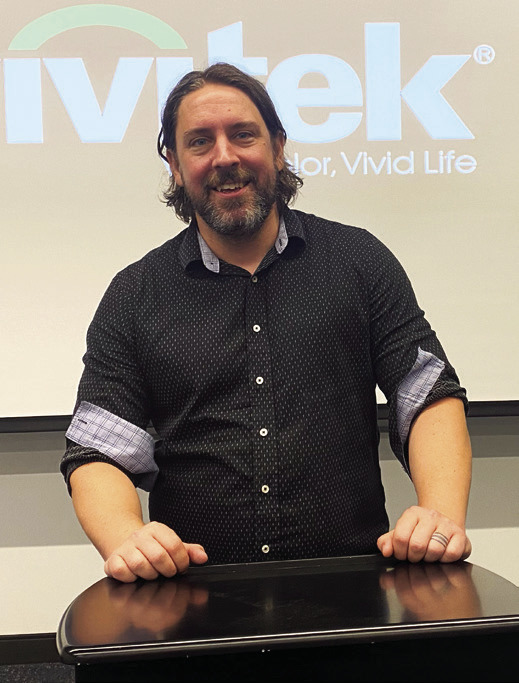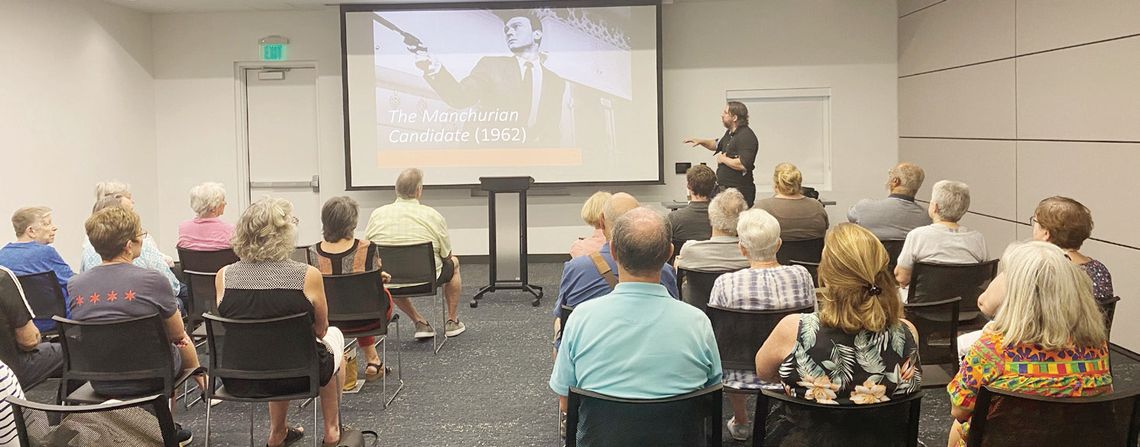LIFELONG LEARNING
What is a cult? Is it a group that brainwashes individuals leaving them unable to think for themselves? Is a cult even a legitimate concept? Joseph Laycock, Texas State University Religious Studies assistant professor, thinks that brainwashing is an outdated and often misguided term and that the term “cult” is not specific enough to offer any solutions or a real understanding of what is occurring in groups classically labeled that way.
During Lifelong Learning SMTX’s current lecture series, Laycock dives into the history of these terms and offers new, more useful verbiage. The series occurs from 10 to 11:30 a.m. every Monday at the San Marcos Public Library until Sept. 30.
Laycock said the Cult Wars occurred from 1965 to 1987, which was when the term “brainwashing” was introduced in an article by a CIA propagandist named Edward Hunter.
“This article from the Miami news is the first time the word brainwashing was ever introduced to the public, and it's actually an attempt to translate a Chinese term, which comes out of Confucianism, which originally meant more like purifying the heart. It got translated into brainwashing,” Laycock said. “Basically, what the article is saying is the reason that there are millions of communists in China is because those people are not able to think with their own minds anymore.”
During the Korean War, thousands of American prisoners of war were signing petitions from prison that said, “America is this evil, capitalist, warmongering country.” Twenty-one of the American POWs said, “We don't want to be repatriated to our country. We want to stay here in Korea.” People once again pointed to brainwashing to explain this.

“They say, ‘When they were in this POW camp, they were exposed to these techniques of mind control,’” Laycock said. “The claim was communists, and particularly Chinese Communists, had these ancient ways of controlling your mind. This was framed as a psycho- technology. The CIA said this is exactly like if you're playing a record and you just take the record off and put on a new one. That was the model of brainwashing.”
Laycock said the United States government hired two psychiatrists, Robert Lifton and Edgar Schein, to examine these POWs. They found that the POWs were simply coerced, not brainwashed.
“They were told things like, ‘Say you hate America, or we'll shoot you,’” Laycock said. “That's not mystical. That's not mind control. That is simple coercion. They were in a prison camp. They feared death. They feared torture, so they complied. Very few of them seemed to have actually changed their minds about anything, but the idea of brainwashing, it was still out there.”
In the 1960s there was a shift in thinking related to brainwashing. Previously it was thought to be a tool of espionage, and in the 60s, it was a tool used by cult leaders to control their followers. He said that in 1965, United States President Lyndon Baines Johnson signed the Hart-Cellar Immigration and Nationality Act, which opened the door for immigrants from Asia, and with that came religions from those countries.
“This was the beginning of the Unification Church with Reverend Moon in Korea coming in and introducing this religion. This was the beginning of the International Society for Krishna Consciousness, also known as the Hare Krishnas,” Laycock said. “So these strange religions begin to show up, which America has never seen before. And this begins this concern about so-called ‘cults.’ This is happening in the context of the counterculture of the 1960s, so there's people saying, ‘I sent my son to Berkeley, and now he has shaved his head and is chanting in Sanskrit. What the heck is going on?’” Out of this came the idea of deprogramming in which parents could pay someone to essentially counter-brainwash their kids into having what they considered to be an acceptable point of view. He showed a flier from that time that read, “We must change the First Amendment. Our forefathers meant this to be a Christian Country.” He then pointed out why this type of thinking could hinder religious freedom.
“For somebody like me who's very interested in religious freedom and who takes the First Amendment very seriously, this is why this discussion of brainwashing and cults is dangerous,” Laycock said. “This could really potentially throw the idea of religious freedom in the First Amendment out the window if you say, ‘Some religions are real religions, and some religions are more akin to a disease. There's just something wrong with your brain, and we just have to clear it up.’ This is where we were during the so-called Cult Wars.”
In 1974, Robin George ran away when she was 14 years-old and went to live with the Hare Krishnas. Later George reconciled with her family and claimed to be brainwashed. The family sued the group for $32 million and won, which was the largest settlement in history at that time. Margaret Singer was an expert witness in that case, as well as many others, and formed a special task force of the American Psychological Association, which she called Deceptive and Indirect Methods of Persuasion and Control — also known as brainwashing.
“The American Psychological Association reads this report from Margaret Singer and her colleagues, and it says, ‘Look, this isn't science, and we don't back it up,’” Laycock said, adding that the APA did not believe that brainwashing was real and denounced her as an expert, which ended Singer’s expert witness career. “One thing I want to think about here is when people talk about brainwashing, it's often an excuse… In other words, nobody wants to say, ‘I was tricked. I made a bad decision.’ For a lot of reasons, it's better to say you were brainwashed.”
Kathy Wessinger, a colleague of Laycock’s, is an expert on the Branch Davidians and what happened with that group in Waco. According to History. com, there was a 51day standoff between federal agents and members of a millennial Christian sect called the Branch Davidians. The siege ended when fires consumed the compound, leaving some 75 people dead, including 25 children. Wessinger said the term “cult is an inaccurate, unhelpful and dangerous label,” and could be to blame for the federal agents' treatment of the Branch Davidians.
“Here's a quote from Kathy Wessinger, ‘It's important that people become aware of the bigotry convened by cult. The word cult dehumanizes their religious members and their children. It strongly implies that these people are deviants. They are seen as crazy, brainwashed, duped by their leader. We label people as subhuman. We create a context in which it is considered virtuous to kill them,’” Laycock read. “So for her, the word cult, it’s not just that it's politically incorrect, but it's actually potentially dangerous.”
Laycock said there is a concern in his field that the word cult “takes the place of actual analysis” and that the definition is unclear.
“It's a connotative word, meaning it implies a lot of bad things without actually saying them out loud,” Laycock said, adding that makes it useful as a political tool but terrible for social sciences since it is not precise.
He then pointed to a specific type of group that is often labeled as a cult.
“I think that we need a better term to kind of look at this. So this leads us to… a Nativist Millennialist Movement,” Laycock explained. “We'll start with this term millennialism. Millennialism, in religious studies, refers to a belief in some kind of collective salvation for the group and usually one that is imminent.”
Laycock said there is usually a prophet or messiah figure in a millennialist movement, and Wessinger said that nativist is a specific type of millennialism that “consists of people who feel under attack by a foreign colonizing government.” He said they could actually be under attack or just believe it, but either way, they believe that there will be an imminent collective salvation. Wessinger believed that “if you have a group like this and their hopes are thwarted, one of the possibilities is a violent outcome.” Laycock used the example of Q-Anon, which Britannica described as “conspiracy adherents” that “believed that U.S. Pres. Donald Trump was waging a secret war against a cabal of satanic cannibalistic pedophiles within Hollywood, the Democratic Party, and the socalled ‘deep state’ within the United States government.” They believed that Trump would win the presidential election in 2020. When he did not win the election, it “resulted in legal protests as well as several violent criminal incidents,” Britannica said.
The Oxford Academic website gave the Ghost Dance as another example of a Nativist Millennialist movement in which “prophet-dreamers in western Nevada… announced the imminent return of the dead, the ousting of the whites and the restoration of Native American lands, food supplies and way of life,” which would be hastened by “the dances and songs revealed to the prophets in their vision visits to the spirit world and also by strict observance of a moral code,” according to Britannica.
One can register at the San Marcos Public Library for the remainder of the lecture series by calling 512393-8200. The schedule for upcoming courses in the series and descriptions can be found at lllsanmarcos.org/community- events.







